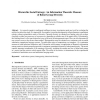Free Online Productivity Tools
i2Speak
i2Symbol
i2OCR
iTex2Img
iWeb2Print
iWeb2Shot
i2Type
iPdf2Split
iPdf2Merge
i2Bopomofo
i2Arabic
i2Style
i2Image
i2PDF
iLatex2Rtf
Sci2ools
AROBOTS
2000
2000
Hierarchic Social Entropy: An Information Theoretic Measure of Robot Group Diversity
As research expands in multiagent intelligent systems, investigators need new tools for evaluating the artificial societies they study. It is impossible, for example, to correlate heterogeneity with performance in multiagent robotics without a quantitative metric of diversity. Currently diversity is evaluated on a bipolar scale with systems classified as either heterogeneous or homogeneous, depending on whether any of the agents differ. Unfortunately, this labeling doesn't tell us much about the extent of diversity in heterogeneous teams. How can it be determined if one system is more or less diverse than another? Heterogeneity must be evaluated on a continuous scale to enable substantive comparisons between systems. To enable these types of comparisons, we introduce: (1) a continuous measure of robot behavioral difference, and (2) hierarchic social entropy, an application of Shannon's information entropy metric to robotic groups that provides a continuous, quantitative measu...
AROBOTS 2000 | Hierarchic Social Entropy | Multiagent Intelligent Systems | Robot Behavioral Difference |
| Added | 17 Dec 2010 |
| Updated | 17 Dec 2010 |
| Type | Journal |
| Year | 2000 |
| Where | AROBOTS |
| Authors | Tucker R. Balch |
Comments (0)

